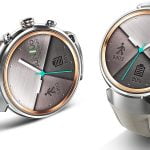
Researchers at Memorial Sloan Kettering Cancer Center stretch their communication muscles during an improv-inspired workshop in December 2016.
A group of scientists stand in a circle for a seemingly simple game. One claps their right hand to their opposite shoulder and says “one.” The person to their left makes the same motion and says “two.” The clap continues clockwise around the circle until the group has counted up to seven. Then, suddenly, the clap starts circling the other direction. If all goes well, everyone copies the change—which lasts until they reach seven again and something new happens. Once everyone gets the hang of it, the group splits into two smaller circles, which keep playing on their own. When someone messes up, they’re supposed to run over to join the other circle—but it’s on the honor system, and they have to relocate voluntarily.
Facilitator Aniek Ivens says it plays out pretty much the same every time. The game starts off slow, with people trying to ignore their errors and others itching to call them out. “It’s so hard at first to police yourself, to admit that you made a mistake. And it’s also really, really hard, apparently, to not tell others they did something wrong,” she says. But as people settle into a rhythm, “there’s all smiles, total chaos, people running back and forth.” It’s one of Ivens’s favorite games to play during the improv-inspired communication workshops she runs for scientists.
Ivens is also a scientist herself, and she knows firsthand that improv can be a powerful training tool. Her improv experience means she’s used to feigning confidence, even when a skit takes her places she never would have imagined, so she doesn’t get nervous presenting her own research, she says. “We’re all perfectionists; that’s what we’re selected for as a scientist,” says Ivens, who spends her days studying relationships between ants and their symbionts as a postdoctoral fellow at Vrije Universiteit in Amsterdam. But just like important scientific discoveries that have come out of accidents, sometimes you can create stronger connections when you make a mistake, she says. “From things that go wrong, the most beautiful stories emerge.”
So she teaches her students to draw on improv’s “yes, and” philosophy of going along with what happens, even when it isn’t what you might have preferred. She focuses on key skills, or “muscles,” that she often sees scientists struggling with at conferences and in presentations—including reading an audience, communicating complicated ideas in an accessible way, being comfortable when things go wrong, and redirecting smoothly to get back on track.
She has also employed some improv-like flexibility in her own career development. Ivens had long dreamed of becoming an actress, but in her early 20s, she decided to focus on science instead. She found herself missing acting during her Ph.D. studies, though, so she dialed back her research to 4 days a week and devoted the extra time to acting jobs, including taking part in police training skits, coaching improv teams, and offering improv workshops to professional groups. She continued blending science and improv during a postdoc at Rockefeller University in New York City, where she participated in weekly evening practice sessions and occasional performances with a group called the Hand-Me-Downs. She also offered communication workshops tailored to scientists. (When she attended an improv and storytelling boot camp for scientists in January 2016 at the Alan Alda Center for Communicating Science at Stony Brook University in New York, she was pleased to see that they used some of the same exercises she was already sharing with scientists.)
A key skill that scientists in her improv courses often want to focus on is speaking compellingly about their work. One of her exercises to practice this involves arbitrarily declaring one participant an expert on a random topic who must field questions about it from the rest of the group. Usually, participants panic a little at first, she says, but as they settle into the exercise, they realize they can think on their feet and even crack some jokes. Experiencing that with a random topic, and in a Q&A format, which is harder to control than a prepared talk, makes the prospect of facing the same ordeal with their own research much less scary.
Ivens also helps researchers cut out jargon and use creative explanatory devices. Metaphors, for example, can be very useful for conveying complex topics, but, Ivens notes, it can be tricky to develop one that is accurate without getting bogged down in whether it holds at the smallest level of detail. “I always stress don’t dumb it down; that’s absolutely not necessary,” she says. The key is to provide context and make your work accessible. “We are so excited about what we do that we think everybody should like this and everybody should be excited about this,” she says. “So we skip the step of telling them why it should be exciting.”
Ivens herself is far from shy about sharing her excitement. She gives outreach talks about her own research and hopes to end up in a position where she can balance research, teaching, performance, and workshops—combining her worlds to make each stronger.
[“Source-ndtv”]










